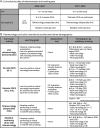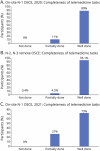Curriculum Innovations: A Comprehensive Teleneurology Curriculum for Neurology Trainees
- PMID: 39359705
- PMCID: PMC11419297
- DOI: 10.1212/NE9.0000000000200084
Curriculum Innovations: A Comprehensive Teleneurology Curriculum for Neurology Trainees
Abstract
Introduction and problem statement: As the role of teleneurology expands, it is important to prepare trainees to perform virtual encounters proficiently.
Objectives: We created a comprehensive multimodality teleneurology curriculum for residents to teach key aspects of telehealth encounters including the virtual examination and skill development across several environments.
Methods and curriculum description: We developed and implemented a teleneurology curriculum focused on teaching the virtual neurologic examination, measuring teleneurology competency, and providing opportunities for trainees to perform telehealth encounters in multiple settings. Residents (N = 22) were first surveyed on what methods would be most helpful to learn teleneurology. Trainees observed a faculty member conducting a teleneurology visit with another faculty member playing a patient. Residents then practiced a teleneurology encounter during a 10-minute objective structured clinical examination (OSCE) at a simulation center. After positive feedback from the fall of 2020, we adapted the OSCE to be completely remote in the spring of 2021 for senior residents. Trainees then performed teleneurology visits during their continuity clinics and subspecialty clinic rotations.
Results and assessment data: All neurology residents from adult and child neurology and neuropsychiatry programs at New York University Grossman School of Medicine participated in the curriculum. Residents identified a variety of teaching modalities that would help them learn teleneurology: didactics with slides (25%), live demonstration (25%), simulated experience (23%), starting with live patients (23%), and articles/reading material (4%). To date, 68 trainees participated in the OSCE. Trainees who completed on-site and remote simulations reported increased comfort (p < 0.05) and interest in teleneurology (p < 0.05) and requested more access to simulations during training. Sensorimotor assessment and adequate visualization of the affected limb were identified as areas for improvement.
Discussion and lessons learned: Our multimodal 3-year teleneurology curriculum provides opportunities for residents to learn and apply teleneurology. Survey tools helped strengthen the curriculum to optimize educational potential. We implemented a teleneurology simulation with and without the use of a simulation center. We plan to expand our teleneurology clinical and simulation experiences to trainees based on our data and further developments in teleneurology and to track the progress of teleneurology skills as residents advance through training.
© 2023 American Academy of Neurology.
Conflict of interest statement
S.C. Han and R.S. Stainman report no disclosures relevant to the manuscript. N.A. Busis has received personal compensation for serving as CPT advisor for the American Academy of Neurology (AAN) and for AAN speaking engagements. S.N. Grossman, S.P. Thawani, and A.M. Kurzweil report no disclosures relevant to the manuscript. Go to Neurology.org/NE for full disclosures.
Figures





Similar articles
-
Management of Poisoned Patients: Implementing a Blended Toxicology Curriculum for Emergency Medicine Residents.J Educ Teach Emerg Med. 2022 Apr 15;7(2):C1-C32. doi: 10.21980/J8C937. eCollection 2022 Apr. J Educ Teach Emerg Med. 2022. PMID: 37465448 Free PMC article.
-
Education Research: An experiential outpatient teleneurology curriculum for residents.Neurology. 2019 Jul 23;93(4):170-175. doi: 10.1212/WNL.0000000000007848. Neurology. 2019. PMID: 31332085
-
Training in Neurology: Implementation and Evaluation of an Objective Structured Clinical-Examination Tool for Neurology Postgraduate Trainees in Lusaka, Zambia.Neurology. 2021 Aug 17;97(7):e750-e754. doi: 10.1212/WNL.0000000000012134. Epub 2021 Apr 30. Neurology. 2021. PMID: 33931541
-
"I Don't Trust It": Use of a Routine OSCE to Identify Core Communication Skills Required for Counseling a Vaccine-Hesitant Patient.J Gen Intern Med. 2022 Jul;37(9):2330-2334. doi: 10.1007/s11606-022-07495-4. Epub 2022 Jun 16. J Gen Intern Med. 2022. PMID: 35710665 Free PMC article. Review.
-
Exploring the Role of Simulation Training in Improving Surgical Skills Among Residents: A Narrative Review.Cureus. 2023 Sep 4;15(9):e44654. doi: 10.7759/cureus.44654. eCollection 2023 Sep. Cureus. 2023. PMID: 37799263 Free PMC article. Review.
Cited by
-
Education Research: Trends of Neurology Clerkships in the United States Amidst a Global Pandemic.Neurol Educ. 2024 Nov 6;3(4):e200169. doi: 10.1212/NE9.0000000000200169. eCollection 2024 Dec. Neurol Educ. 2024. PMID: 39834897 Free PMC article.
References
-
- Accreditation Council for Graduate Medical Education. ACGME Response to COVID-19: Clarification Regarding Telemedicine and ACGME Surveys. ACGME; 2020.
-
- Association of American Medical Colleges. Telehealth Competencies Across the Learning Continuum. AAMC New and Emerging Areas in Medicine Series. AAMC; 2021.
LinkOut - more resources
Full Text Sources
Research Materials
